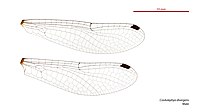Cordulephya divergens
Appearance
(Redirected from Clubbed shutwing)
| Clubbed shutwing | |
|---|---|
| Scientific classification | |
| Domain: | Eukaryota |
| Kingdom: | Animalia |
| Phylum: | Arthropoda |
| Class: | Insecta |
| Order: | Odonata |
| Infraorder: | Anisoptera |
| Genus: | Cordulephya |
| Species: | C. divergens
|
| Binomial name | |
| Cordulephya divergens | |

| |
Cordulephya divergens is a species of dragonfly in the superfamily Libelluloidea,[3][4] commonly known as the clubbed shutwing.[5] It inhabits streams in the Sydney Basin, Australia.[6][7]
Cordulephya divergens is a small to tiny, black or purplish-black dragonfly with yellowish markings. It rests with its wings folded above its body in a similar manner to a damselfly.[5]
Gallery
[edit]-
Female wings
-
Male wings
See also
[edit]References
[edit]Wikimedia Commons has media related to Cordulephya divergens.
- ^ Dow, R.A. (2017). "Cordulephya divergens". IUCN Red List of Threatened Species. 2017: e.T14272602A59256573. doi:10.2305/IUCN.UK.2017-1.RLTS.T14272602A59256573.en. Retrieved 20 November 2021.
- ^ Tillyard, R.J. (1917). "On some new dragonflies from Australia and Tasmania (Order Odonata)". Proceedings of the Linnean Society of New South Wales. 42: 450–479 [467]. doi:10.5962/bhl.part.4860 – via Biodiversity Heritage Library.
- ^ "Species Cordulephya divergens Tillyard, 1917". Australian Faunal Directory. Australian Biological Resources Study. 2022. Retrieved 1 September 2024.
- ^ Paulson, D.; Schorr, M.; Abbott, J.; Bota-Sierra, C.; Deliry, C.; Dijkstra, K.-D.; Lozano, F. (2023). "World Odonata List". OdonataCentral, University of Alabama. Retrieved 14 Mar 2023.
- ^ a b Theischinger, Günther; Hawking, John (2021). The Complete Field Guide to Dragonflies of Australia (2nd ed.). Melbourne, Australia: CSIRO Publishing. p. 406. ISBN 9781486313747.
- ^ Theischinger, Gunther; Endersby, Ian (2009). Identification Guide to the Australian Odonata. Department of Environment, Climate Change and Water NSW. p. 209. ISBN 978-1-74232-475-3.
- ^ Watson, J.A.L.; Theischinger, G.; Abbey, H.M. (1991). The Australian Dragonflies: A Guide to the Identification, Distributions and Habitats of Australian Odonata. Melbourne: CSIRO. p. 278. ISBN 0643051368.



